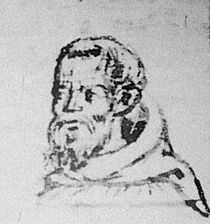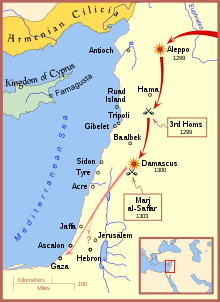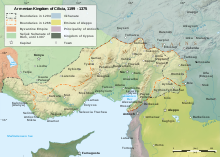Hethum II
| Hethum II Հեթում Բ | |
|---|---|
 King Hethum II, in Franciscan gown | |
| King of Cilician Armenia | |
| Reign | 1289–1293 |
| Predecessor | Leo II |
| Successor | Thoros III |
| King of Cilician Armenia | |
| Reign | 1295–1296 |
| Predecessor | Thoros III |
| Successor | Sempad |
| Co-ruler | Thoros III |
| King of Cilician Armenia | |
| Reign | 1299–1303 |
| Predecessor | Constantine I |
| Successor | Leo III |
| Regent of Cilician Armenia | |
| Regency | 1303–1307 |
| Monarch | Leo III |
| Born | 1266 |
| Died | November 17, 1307(aged 40–41) Anazarbus |
| Dynasty | Hethumids |
| Father | Leo II |
| Mother | Keran of Lampron |
| Religion | Armenian Church |
Hethum II(Armenian:Հեթում Բ;1266– November 17, 1307), also known by several other romanizations,[a]was king of theArmenian Kingdom of Cilicia,ruling from 1289 to 1293, 1295 to 1296 and 1299 to 1303, while Armenia was a subject state of theMongol Empire.He abdicated twice in order to take vows in theFranciscan order,while still remaining the power behind the throne as "Grand Baron of Armenia" and later as Regent for his nephew. He was the son ofLeo II of ArmeniaandKyranna de Lampron,and was part of theHethumid dynasty,being the grandson ofHethum I,who had originally submitted Cilicia to the Mongols in 1247. He was assassinated with his nephew and successorLeo IIIby the Mongol generalBilarghu,who himself was later executed for this by the MongolIlkhanrulerÖljaitü.[1]
First reign
[edit]Since 1247,Cilician Armeniaitself had been a vassal state of the Mongol Empire, from an agreement made by Hethum II's grandfather,Hethum I.As part of this relationship, Cilician Armenia routinely supplied troops to the Mongols, cooperating in battles against the Mamluks and other elements of the Islamic empire.
Hethum II took the throne in his early 20s, when his father Leon II died in 1289. At the time, Cilician Armenia was in a precarious position between major powers, balancing between friendly relations with the Christian Europeans and Byzantine Empire, aggression from the TurkishSultanate of Rumto the west, a vassal relationship with the aggressive Mongol Empire in the East, and defending itself from attacks from the South, from the Muslim Mamluks out of Egypt. The Crusades had lost European support and were winding down, and Islamic forces were sweeping northwards from Egypt, re-taking land which had earlier been lost to the Crusaders,[2]and pushing back against the Mongol advance.
In 1289,Angelo da Clarenoand a few otherSpiritual Franciscansarrived tomissionizeamong theArmenian Christians.They had been repeatedly jailed in Italy for their strong condemnations of luxury in the church but they won favor at the Armenian court.St Thomas of Tolentinowas sent by Hethum to Rome, Paris, and London to advocate another crusade to support the Armenians; he failed in this, but returned with additional clerics to support the mission and advocate the reunification of theArmenian ChurchwithRome.
In 1292,Cilician Armeniawas invaded byKhalil,theMamluksultan ofEgypt.His father the Mamluk sultanQalawunhad earlier broken the treaty of 1285, was marching North through Palestine with his troops, and also demanded the surrender of the Armenian cities ofMarashandBehesni.Qalawun died before the campaign was completed, but Khalil continued his father's advance northwards, and had conquered theKingdom of Jerusalemin 1291 at theSiege of Acre.Khalil's forces continued on from there, sacking the Armenian city ofHromgla,which was defended by Hethum's uncle, Raymond, but fell after a siege of 33 days. To stave off further invasion, Hethum II abandoned the cities of Marash, Behesni, andTel Hamdounto the Mamluks.
In 1293, Hethum abdicated in favor of his brotherThoros IIIand entered the Franciscan monastery at Mamistra. He did stay active in the politics of the kingdom though, and negotiated with the Egyptian leaderKetboughafor the return of the prisoners who had been taken at Hromgla, as well as for some church relics which had been pillaged.[2]
Second reign
[edit]In 1295, Thoros III asked Hethum to resume the throne to help renew the Mongol alliance. Hethum made the long journey to the Mongol capital, and was successfully able to request aid from the Mongols. When he returned to Armenia in 1296, further good news manifested from the Byzantine Empire, with an offer of a marital alliance. Hethum and Thoros placed Armenia under the regency of their brotherSempad,and traveled toConstantinopleto bestow their sisterRitaupon theByzantine EmperorMichael IX Palaeologus.However, during their absence Sempad usurped the Armenian throne with the aid of another brother,Constantine.Hethum and Thoros were both captured inCaesareaupon their return, and imprisoned in the fortress ofPartzerpert.There, Hethum was partially blinded bycauterization.Thoros was murdered in Partzerpert in 1298; but Constantine turned against Sempad, usurped the throne for himself, imprisoned Sempad and freed Hethum.[2]

Third reign
[edit]


In 1299, Hethum, recovered at least partially from his blindness, ousted Constantin and once again resumed the crown. Soon thereafter, he again sought assistance fromGhazan's Mongols,[4]and fought against the Mamluks in Syria. The combined forces achieved a major victory at the December 1299Battle of Wadi al-Khazandar[4](sometimes called the Battle of Homs), takingDamascus,and Hethum was able to regain all of the Armenian territory which had previously been lost to the Mamluks.[2]One group of Mongols split off from Ghazan's army and was even able to launch someMongol raids into Palestine,pursuing the retreating Egyptian Mamluk troops as far south asGaza,[5]pushing them back to Egypt.
According to modern traditions, Hethum may have visitedJerusalemin 1300 during this time.[4]However, historians disagree as to whether or not the visit actually occurred. Angus Donal Stewart points out that the source of the tradition, a medieval account by the Armenian historianNerses Balients,does not match with any other accounts by any other historians of the time period, and was simply written as Armenian propaganda of the time.[6][7]However, Claude Mutafian, inLe Royaume Arménien de Cilicie,suggests that it may have been on this occasion that Hethum remitted his amber scepter to the Armenian convent ofSaint James of Jerusalem.[3]
The king of Armenia, back from his raid against the Sultan, went to Jerusalem. He found that all the enemies had been put to flight or exterminated by the Tatars, who had arrived before him. As he entered into Jerusalem, he gathered the Christians, who had been hiding in caverns out of fright. During the 15 days he spent in Jerusalem, he held Christian ceremonies and solemn festivities in the Holy Sepulchre. He was greatly comforted by his visits to the places of the pilgrims. He was still in Jerusalem when he received a certificate from the Khan, bestowing him Jerusalem and the surrounding country. He then returned to join Ghazan in Damas, and spend the winter with him
Speculation aside, the Mongols retreated northwards a few months later, and the Mamluks reclaimed Palestine with little resistance.
Hethum's gains against the Mamluks were short-lived, as in 1303, the Mamluks counter-attacked from Egypt. The Armenians again joined forces with a sizable number of Mongol troops, 80,000, on a Syrian offensive, but they were defeated at Homs on March 30, 1303, and at the decisiveBattle of Shaqhab(Merj-us-Safer), south of Damas, on April 21, 1303.[9]This campaign is considered to be the last major Mongol invasion of Syria.[10]Hethum retreated to Ghazan's court inMoussoul,and then again resigned his crown. His brother Thoros III having been killed in 1298, Hethum passed the crown to Thoros's teenaged son,Leo III.Hethum retired to a monastery, although as Leo was not yet an adult, Hethum retained the office of Regent of Armenia.
Later years
[edit]
In 1304, theMamlukscontinued their assault onCilician Armenia,and succeeded in taking back all the lands which the Armenians had acquired during the Mongol invasion. The Mamluks wanted to punish the Armenians for allying with the Mongols.
The Armenian Kingdom of Cilicia's alignment with the Mongol Empire continued, motivated as much by the need for self-protection from theSeljuk Sultanate of Rûmon their western borders as self-interest in acquiring territory to the east, albeit short-lived. Following the conversion of the Mongol IlkhanGhazanto Islam in 1295, his successorÖljaitüexercised less control over outlying countries under Mongol protection and reduced the military campaigns against the Mamluks in Syria. According to contemporary Arabic and Persian accounts, one of his generals,Bilarghu,a devout Muslim, had indicated his intention to erect amosquein the city ofSis,still part of the Christian Kingdom of Armenia, possibly as part of a wider plan to place the province under his own control. Hethum conveyed his worries about these plans by letter to Öljaitü. He was subsequently summoned by Bilarghu to a meeting on November 17, 1307, in an encampment beneath the walls of the royal stronghold ofAnazarbus(Caesareain theRoman provinceofCilicia), either to hold counsel or for abanquet.Hethum attended with about 40 noblemen and his young nephewKing Leon,for whom asGrand Baronhe was acting as regent.Bilarghu,however, had learnt of Hethum's letter and ordered his men to massacre the Armenian king and his guests upon their arrival. When the Armenians arrived for thebanquet,they were massacred while having their meals along with Hethum and his nephewKing Leon.Following this assassination, Hethum's brotherOshin,heir to the throne, occupied Sis. He sent another brother Alinakh to report on Bilarghu's treachery toÖljaitü,who ordered the immediate execution ofBilarghuand his soldiers and confirmed his support of Oshin as king asLeo IIIhad no heirs since he was too young to marry when he was murdered.[1]
Notes
[edit]- ^His name has been writtenHaython,Hayton,Het'um,Hetoum,andHethoum.
References
[edit]Citations
[edit]- ^abStewart 2005
- ^abcdKurkjian, pp. 204–205
- ^abClaude Mutafian, pp. 73–75
- ^abcDemurger, pp. 142–143
- ^Demurger, p.142 "The Mongols pursued the retreating troops towards the south, but stopped at the level of Gaza"
- ^Stewart,Armenian Kingdom and the Mamluks,p. 14. "At one point, 'Arab chroniclers' are cited as being in support of an absurd claim made by a later Armenian source, but on inspection of the citations, they do no such thing." Also Footnote #55, where Stewart further criticizes Schein's work: "The Armenian source cited is theRHC Arm. Iversion of the 'Chronicle of the Kingdom', but this passage was in fact inserted into the translation of the chronicle by its editor, Dulaurier, and originates in the (unreliable) work of Nerses Balienc... The "Arab chroniclers" cited are Mufaddal (actually a Copt; the edition of Blochet), al-Maqrizi (Quatremere's translation) and al-Nuwayrf. None of these sources confirm Nerses' story in any way; in fact, as is not made clear in the relevant [Schein] footnote, it is not the text of al-Nuwayrf that is cited, but D.P. Little's discussion of the writer in hisIntroduction to Mamluk Historiography(Montreal 1970; 24–27), and in that there is absolutely no mention made of any Armenian involvement at all in the events of the year. It is disappointing to find such a cavalier attitude to the Arabic source material. "and" Echoes of Hayton'sFlor des estoiresespecially can be found in many works that touch on the kingdom, while this is an extremely tendentious work, designed to be a piece of propaganda. "Stewart, p. 15
- ^Amitai,Mongol Raids into Palestine, 1987
- ^Historiens Armeniens, p.660
- ^Demurger, p. 158
- ^Nicolle, p. 80
Bibliography
[edit]- Amitai, Reuven(1987). "Mongol Raids into Palestine (AD 1260 and 1300)".Journal of the Royal Asiatic Society:236–255.
- Boase, T. S. R. (1978).The Cilician Kingdom of Armenia.Edinburgh: Scottish Academic Press.ISBN0-7073-0145-9.
- Demurger, Alain(2007).Jacques de Molay(in French). Editions Payot&Rivages.ISBN978-2-228-90235-9.
- Edwards, Robert W. (1987).The Fortifications of Armenian Cilicia: Dumbarton Oaks Studies 23.Washington, D.C.: Dumbarton Oaks, Trustees for Harvard University.ISBN0-88402-163-7.
- Kurkjian, Vahan M.(1958).A History of Armenia.Indo-European Publishing.ISBN978-1-60444-012-6.
- Mutafian, Claude(2001) [1993].Le Royaume Armenien de Cilicie(in French).CNRS Editions.ISBN2-271-05105-3.
- Nicolle, David(2004).The Mongol Warlords: Genghis Khan, Kublai Khan, Hulegu, Tamerlane.Brockhampton Press.ISBN1-86019-407-9.
- Stewart, Angus (2005)."The Assassination of King Het'um II: The Conversion of The Ilkhans and the Armenians".Journal of the Royal Asiatic Society.15(1): 45–61.doi:10.1017/S1356186304004687.hdl:10023/1563.S2CID55809524.
- Stewart, Angus Donal (2001).The Armenian Kingdom and the Mamluks: War and diplomacy during the reigns of Het'um II (1289–1307).BRILL.ISBN90-04-12292-3.
